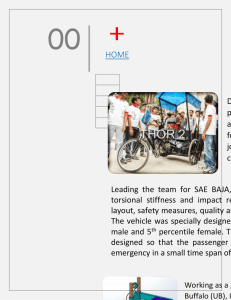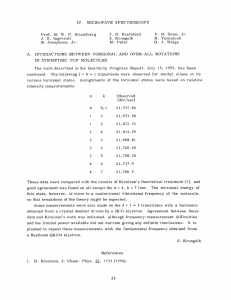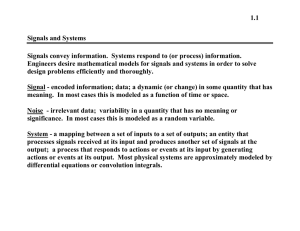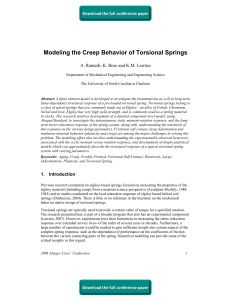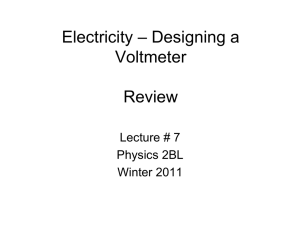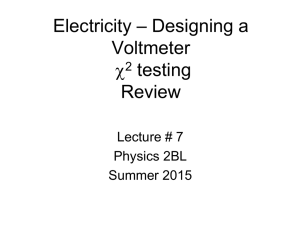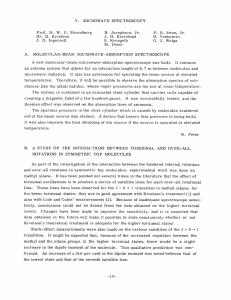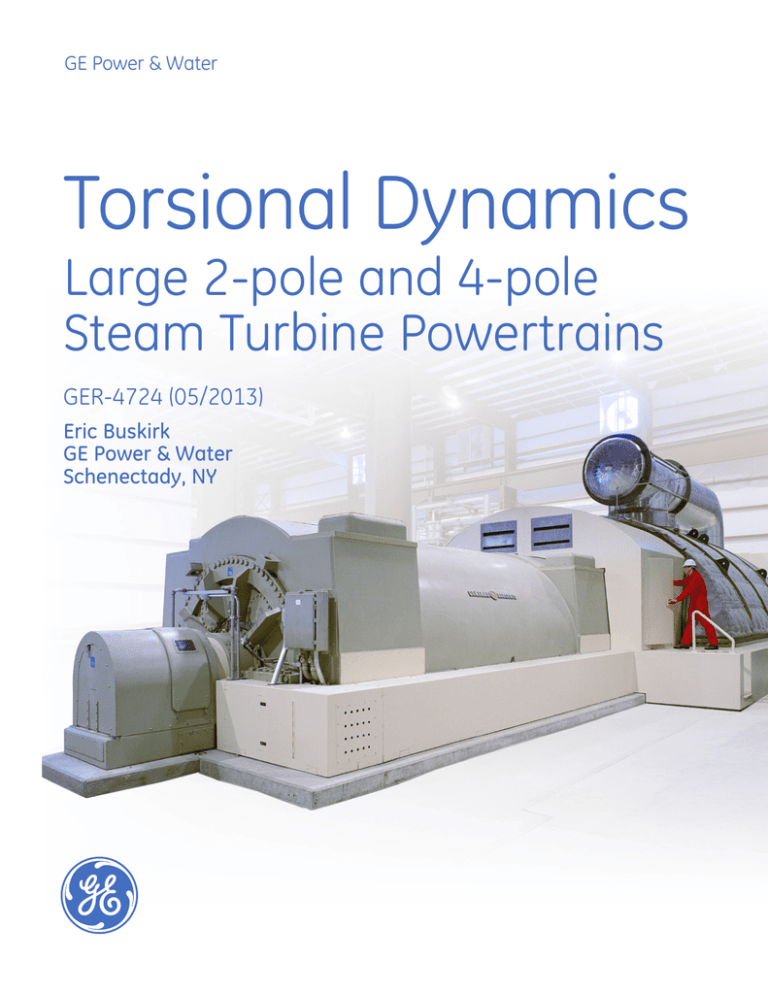
GE Power & Water
Torsional Dynamics
Large 2-pole and 4-pole
Steam Turbine Powertrains
GER-4724 (05/2013)
Eric Buskirk
GE Power & Water
Schenectady, NY
Table of Content
Introduction................................................................................................................................................................ 1
Rotordynamic Basics............................................................................................................................................... 1
Powertrain example.......................................................................................................................................... 2
How to interpret results.................................................................................................................................. 2
Consequences of torsional resonance and mitigating risk.................................................................. 4
Torsional Testing....................................................................................................................................................... 5
Rotating Strain-Based Test............................................................................................................................. 5
Nonrotating Impact Test................................................................................................................................. 6
Rotating Displacement-Based Test.............................................................................................................. 6
Torsional Frequency Margin.................................................................................................................................. 7
ISO-22266............................................................................................................................................................ 7
General Electric.................................................................................................................................................. 8
Torsional Tuning........................................................................................................................................................ 9
Inertia Tuning..................................................................................................................................................... 9
Dynamic Tuning................................................................................................................................................. 9
Other Tuning Options....................................................................................................................................... 10
Conclusion.................................................................................................................................................................. 10
References.................................................................................................................................................................. 10
Appendix A.................................................................................................................................................................. 11
Vibration Basics................................................................................................................................................. 11
Vibration Resonance......................................................................................................................................... 11
GER-4724
©2013, General Electric Company. All rights reserved.
Torsional Dynamics Large 2-pole and 4-pole Steam Turbine Powertrains i
ii Torsional Dynamics Large 2-pole and 4-pole Steam Turbine Powertrains
©2013, General Electric Company. All rights reserved.
GER-4724
Introduction
When disturbed from rest, all mechanical structures will vibrate at particular frequencies. The values of these frequencies depend
primarily on the mass and stiffness properties of the specific structure. A good example is striking a bell will make it “ring” with
a particular tone or note (frequency). A large power train rotor is no different. The rotor will have preferred frequencies (natural
frequencies) at which it tends to vibrate laterally where the rotor will bend perpendicular to the axis of rotation. Additionally, the rotor
has preferred frequencies of torsional vibration where the rotor tends to twist about the axis of rotation.
Figure 1 – Lateral vibration
Figure 2 – Torsional vibration
This paper will discuss torsional vibration as it refers to large 2-pole and 4-pole steam turbine powertrains. Torsional vibration,
like lateral vibration, can be detrimental to powertrain operation. Many customers and insurance companies have recently become
increasingly aware of the importance of torsional vibration.
Rotordynamic Basics
A basic review of vibration can be found in Appendix A. Rotating equipment analysis uses the basic mass/spring behavior described
above and applies it to the entire rotor. Powertrain engineers create a “rotor model” for each rotor section (steam turbine, generator,
exciter, etc.) and then piece them together to model the entire powertrain. Figure 3 is a simple example to illustrate a rotor model.
Generator Rotor
Generator Rotor
Model
Mass/Spring
Representatrion
Figure 3 – Rotor model description
To create each rotor model, detailed configuration information is required. The rotor shaft sections are “sliced” into small pieces. Each
piece will have a stiffness and mass (inertia). Shaft dimensions, material properties and turbine bucket properties are all required to
make an accurate model. The primary characteristics for lateral analysis are bending stiffness (second area moment of inertia) and
the weight; for torsional analysis the characteristics are torsional stiffness and rotational inertia.
Engineers typically use a computer program to define the rotor models, which creates a mass/stiffness model. A large matrix of
equations of motion is created. The program will take the matrix and calculate the natural frequencies (eigenvalues) and the mode
shapes (eigenvectors). Both are important in understanding the powertrain dynamics.
GER-4724
©2013, General Electric Company. All rights reserved.
Torsional Dynamics Large 2-pole and 4-pole Steam Turbine Powertrains 1
Powertrain Example
Below is a simple example of a fictitious 60 Hz, 2-pole, steam turbine generator powertrain. All rotor models (turbine and generator)
were analyzed together to obtain the result. The torsional natural frequencies are shown below in Figure 4.
Steam Turbine
Generator
Figure 4 – Steam turbine – generator torsional analysis
How to interpret results
The result of the powertrain dynamics analysis gives three pieces of valuable information. First, the natural frequencies, the
frequencies at which the structure will normally to respond is defined. The second is the mode shapes or how the structure will
respond at those particular frequencies. Finally, if the magnitudes of the exciting stimuli are known, the rotor response may also be
determined by what is called a forced response analysis. In each figure, the number indicates the frequency of vibration and the solid
curved line represents the associated mode shape. The vertical scale of the image is angular displacement (twist). The 24.8 Hz mode
can be visualized as the turbine and generator oscillate in opposite directions, the shaft between the generator and turbine twists.
The mode shape is flat in the generator body and steam turbine bucket sections, indicating that no twisting occurs in those shaft
sections. All twisting takes place in the shaft section between the turbine and generator. Note that the twisting occurs while the rotor
is spinning.
2 Torsional Dynamics Large 2-pole and 4-pole Steam Turbine Powertrains
©2013, General Electric Company. All rights reserved.
GER-4724
In the fictitious 60 Hz steam turbine example, there are six modes from 0–200 Hz. Having natural frequencies in the operation speed
range is unavoidable. The problem occurs when a natural frequency exists at the same frequency as system stimuli (vibratory forcing
function). In the case of power generation equipment, it is important to stay away from 1x and 2x the line frequency (60 Hz and
120 Hz). In electrical generating machinery, there is no definable steady state 1x torsional stimulus. The 1x exclusion zone helps to
reduce the response to grid transients, including electrical faults. A generator will also create a 2x stimulus due to “negative sequence
currents” that occur when the phase currents of a 3-phase generator are not perfectly balanced. This results in the generator
creating an oscillating torque at 2x line frequency (120 Hz for a 3600 rpm 2-pole generator) during normal operation. Therefore, for
this example, the structure should be designed to avoid torsional natural frequencies near 60 Hz and 120 Hz. The fictitious steam
turbine example shown in Figure 4 has modes that are located at a safe distance, posing no threat during operation. The simple
steam turbine example has six modes from 0–200 Hz; however, other powertrains can be much more complex. Nuclear steam turbine
generators are particularly complex due to the numerous rotor sections and flexible turbine blades (buckets). The fictitious nuclear
steam turbine-generator example, Figure 5, has ~35 torsional modes from 0–200 Hz. This train would require detailed analysis and
potentially torsional testing to verify safe operation of the powertrain.
Figure 5 – Example of nuclear torsional analysis
Modern engineering and testing along with new analysis tools should be utilized with older turbine generators when modifications or
changes occur. This ensures that torsional frequency margins are acceptable for older powertrains.
GER-4724
©2013, General Electric Company. All rights reserved.
Torsional Dynamics Large 2-pole and 4-pole Steam Turbine Powertrains 3
Consequences of torsional resonance and mitigating risk
A torsional natural frequency that is too close to twice the operating frequency can
cause fatigue damage of a turbine blade (bucket) or shaft section possibly until it fails.
Figure 6 shows damage caused by a torsional resonance to steam turbine buckets
after approximately 10 months of operation. Last stage steam turbine buckets are
particularly susceptible to this type of failure. Additionally, flexible buckets increase
the complexity of a torsional analysis by adding an additional degree of freedom.
The buckets act as flexible elements along with the flexible turbine shaft sections,
creating what is called a “branched system.” Local bucket modes couple together
with the rotor modes, creating complex mode shapes. The flexibility of the buckets
is a critically important factor for determining the overall powertrain behavior.
Mixed trains with multiple OEMs, can be particularly complex to analyze.
Some details necessary to perform torsional analysis are considered proprietary,
making it difficult for OEMs to share information.
Modifications of a turbine, generator, or rotating exciter in a rotor train can
potentially shift resonant frequencies closer to operating frequencies. Even seemingly
small modifications can significantly increase the torsional duty due to a resonance.
The risk of a torsional failure following a modification can be reduced in
several ways, including those listed below:
1)Understand the impact of a rotor train modification on the torsional natural
frequencies and modes. This can be accomplished by a combination of torsional
testing and analytical modeling of the rotor train.
Figure 6 – Turbine bucket damage from
torsional resonance
2)Several approaches can be used to move a natural frequency farther away from the operating frequency, such as adding mass at
a coupling or applying dynamic tuning, which will be discussed later. The combination of torsional testing and analytical modeling
will increase the confidence in the effectiveness of torsional tuning.
3)Accurate component drawings and data are required to create accurate analytical models of the individual rotor components and
the full rotor train. Often, the OEM is the best source for this information. Torsional testing may be needed to validate an analytical
model.
4)Analytical modeling and torsional testing need to account for the impact of load on natural frequencies (see Figure 7). Thermal
effects in rotor modeling should be accounted to best predict torsional natural frequencies. A “cold” and “hot”’ rotor model can be
created to bound the thermal effects on a rotor.
5)The steady-state torsional duty on the rotor train may have increased historically due to changes in the power system
(higher load unbalance, the addition of large non-sinusoidal loads near the plant, a change in the system frequency).
Monitoring of negative sequence currents and operating frequency can be used to alert the operator if a condition exists that may
damage the rotor train components. The operator can then take action to reduce the duty on the rotor train by reducing
load when appropriately-chosen alarm and trip levels are reached. Contact GE for more information on monitoring approaches.
4 Torsional Dynamics Large 2-pole and 4-pole Steam Turbine Powertrains
©2013, General Electric Company. All rights reserved.
GER-4724
Early discussion of torsional considerations by the owner and GE is critically important when changes to a rotor train are being
contemplated. GE vibration experts have considerable expertise in this area. Why be concerned with torsional resonance?
Figure 7 – Torsional test results
Torsional Testing
A typical powertrain is not installed with sensors to monitor torsional vibration, unlike lateral vibration that is monitored by
displacement probes (proximity probes, Bently probes). However, GE can install specialized equipment to measure torsional vibration.
This section discusses the options for performing the test.
Rotating Strain-Based Test
The strain-based test measures direct torsional rotor strain during operation. High-sensitivity strain gages are attached to the rotor in
available shaft sections with a wireless telemetry system. As the rotor spins, the telemetry system sends back a high speed signal of
the rotor strain. The strain signal is analyzed to determine the torsional natural frequencies. This type of test, while typically the most
complex of the ones discussed, yields the most reliable results and is GE’s recommended test method.
This test method has been used by GE since the 1970s and was installed on 200+ powertrains, including 60+ nuclear powertrains.
Prior to the 1990s, this test method was more complex and invasive than modern methods. Previously, the generator was turned into
a large torsional shaker by installing a shorting bar between two phases of the generator. This torsional stimulus would amplify any
small torsional response in the powertrain, making it easier to measure. The modern test still measures torsional rotor strain; however,
advances in equipment and data process allow the test to occur without any modification to normal plant operation (i.e., no shorting
bar). The plant can run under normal operation while the newer, more sensitive strain-based equipment detects torsional response in
the rotor without external stimuli. To fully understand a powertrain’s torsional behavior, the plant is required to hold load constant for
a few hours at a few different MW load levels. Thermal effects in the rotor train can slightly change the torsional stiffness of the train
and thus change the torsional frequencies.
GE currently uses two types of telemetry test equipment: the collar-type system, Figure 8, and strap-type system, Figure 9. Each
installation is typically unit-specific. Both systems require the powertrain to be stationary for roughly 2–3 days (assuming 2-man crew,
12-hour day) while equipment is installed. This is typically performed at the tail end of an outage.
GER-4724
©2013, General Electric Company. All rights reserved.
Torsional Dynamics Large 2-pole and 4-pole Steam Turbine Powertrains 5
Stationary Antenna
Transmitter
Rotor Shaft
Kevlar Belt
Strain Gages
Rotating Transmitter
Figure 8 – Collar-type system
Figure 9 – Strap-type system
The collar-type system has been used by GE for 40+ years. It is a very rugged epoxy-reinforced fiberglass split-collar that bolts onto the
shaft section. This system can handle oil environments and is typically installed under a bearing housing. The equipment can remain
on the shaft during operation for 18–24 months, between nuclear refueling outages. The collar can be installed in oil environments (i.e.,
inside journal housings). The main drawback of the collar system is the lead time and physical shaft size limitation. Some larger 2-pole,
3600 rpm units do not have shaft sections small enough to allow installation of the collar-type system. Slower speed 4-pole units
typically do not have size limitations.
The strap-type system was developed as a more modern version of the torsional testing system that can be used to respond quickly
to a customer’s needs. The system uses updated wireless electronics to transmit the signal along with a different physical mounting
arrangement. This system uses a small transmitter (2”x 2”x ½”) that is held to the rotor with a Kevlar® belt. Due to the high
strength-to-weight ratio of the belt, this system can handle significantly larger shaft sizes for 2 pole units (3000/3600 rpm). The belts
can be quickly produced and are sometimes in stock, providing much shorter lead times. The strap system has two drawbacks. First,
the equipment cannot operate in an oil environment. Second, the system needs to be removed within two months of operation, since
the belt is not intended for long-term operation. Removing the system can be done rather quickly, typically in the same time it takes to
install or remove a balance shot.
Nonrotating Impact Test
A nonrotating impact test can be performed, however, the results are typically not acceptable for an engineering analysis. An
instrumented hammer or shaker is used to provide torsional excitation to a rotor. Accelerometers or strain gages detect the rotor’s
motion to determine natural frequencies. This method is typically the easiest and least expensive test to perform; however, as
mentioned before, the test does not yield acceptable results. Rotors and turbine blades tend to change stiffness with speed and load;
therefore testing at standstill yields different results than testing at speed and load. Additionally, holding the rotor in a true frictionless
manner (free-free) is nearly impossible. Supporting the rotor on lift-oil in its bearings can help reduce the effect of the support.
Additionally, slinging the rotor from crane near predicted response nodes does not work as well. The zero-speed impact/shaker test is
not suggested for torsional testing of a powertrain.
Rotating Displacement-Based Test
A displacement-based test measures the angular displacement of the rotor during operation. The test works by referencing a toothed
wheel or striped optical tape on the rotating rotor. Equipment measures the time between teeth/strips and determines how the rotor
is torsionally twisting while rotating. If the rotor is spinning at a constant speed with no torsional oscillations, the time between teeth/
strips is constant. If the rotor is twisting while spinning, the time between teeth/strips changes in a periodic manner. This type of test
can yield accurate results during operational conditions; however, it tends to not be as accurate as the strain-based method. The
6 Torsional Dynamics Large 2-pole and 4-pole Steam Turbine Powertrains
©2013, General Electric Company. All rights reserved.
GER-4724
signal-to-noise ratio for the test method is lower than the strain-based method. If there is little excitation during the test it is possible
to not detect (i.e., miss) a particular torsional mode.
Note that some GE units have a toothed wheel that is commonly called a “Torsional Monitor.” This system uses a toothed wheel on
the end of the train, typically in the front standard. An eddy current probe measures the time between teeth, similar to the description
above, to determine torsional oscillation. This system can measure sub-synchronous (below 50/60 Hz) torsional modes. The system is
used for grid-interaction studies and cannot be used for testing nearing 2x grid frequency.
Torsional Frequency Margin
When studying any powertrain analytically or reviewing torsional test results, one must ask how close is too close? Frequency margin
is the difference between a natural frequency and the excitation frequency. If a design does not have enough frequency margin,
damaging results can occur.
As mentioned previously, the main frequency that powertrains must avoid is twice line frequency (120 Hz for a 60 Hz grid and 100
Hz for a 50 Hz grid). A generator can create an oscillatory torque at 2x line frequency during a condition when the 3-phase currents
of the generator output are not perfectly balanced. Having adequate frequency margin from 2x is critical for safe operation of a
powertrain. General Electric and the International Standards Organization (ISO) have recommendations for torsional frequency margin.
This section discusses the differences and similarities between the two organizations.
Some power plant insurance companies have taken great interest in torsional natural frequencies. Some insurers set their own
requirements for torsional frequency margin and may require torsional testing for verification. GE engineering can provide support for
torsional testing and analysis to help a customer comply with an insurer’s torsional frequency margin requirements.
ISO-22266
The ISO standard is written to cover any unit in the world. It should be noted that all of the specific torsional frequency margin
values in ISO-22266 are listed as “Informative” and are for guidance. The ISO standard suggests a ±1 Hz margin to the worst case 2x
frequency (B in Figure 10). ISO specifically addresses unstable grid frequencies by allowing up to a ±2.5% (3 Hz, 2x @ 60 Hz) variation
(A in Figure 10). The ISO standard is written generally to allow for both stable and non-stable grid frequencies. If a unit is in a stable
grid it can assume a smaller value than value A.
Figure 10 is a summary of the ISO torsional frequency exclusion zones. Note that the exclusion zones get smaller as better test data is
available. In a stable grid, ISO suggests a ±3.5% (B+C) frequency margin by analysis only. When the ISO standard applies to a unit with
an unstable grid frequency, the resulting frequency margin can extend up to ±6.0% (A+B+C).
ISO-22266
Primary Exclusion Zone (analysis only)
D
D
Full Speed, Factory Test Data
Full Speed Shop Test
E
E
Field Test (full speed, full train)
Allowable Grid
Frequency Varation
C
B
A
A
B
C
1x/2x Line Frequency
50/60 Hz and 100/120 Hz
If tests are carried out at room temperature,
tempurature correction factor, F, should be
added to upper and lower bounds
Informative Limits:
A.Allowable Grid Frequency Deviation ±2.5%
B.Margin from resonance ±1%
C.Calculation Uncertainty ±2.5%
D.Full-speed generator, static LP test ±1%
E. Full-speed generator and LP test ±2%
F. Temperature effects ±1%
Figure 10 – ISO-22266 Torsional frequency margin, reference ISO 22266-1, 2008
GER-4724
©2013, General Electric Company. All rights reserved.
Torsional Dynamics Large 2-pole and 4-pole Steam Turbine Powertrains 7
General Electric
GE’s recommendations for frequency margin are similar to ISO with a few exceptions. It suggests a similar minimum exclusion zone of
±5% (5–6 Hz) with analysis only. Using a full-speed, full-load test at site, the frequency margin reduces to a minimum of ±2 Hz without
further action.
Analysis only (no test) ±5% (5–6 Hz*)
Full-Train Site Test Data ±2 Hz*
General Electric
1x/2x Line Frequency
50/60 Hz and 100/120 Hz
Don’t Operate
Unit ±0.5 Hz*
Tuning Required
* Approximate values at 2x
**Values can vary depending on grid
frequency stability
Figure 11 – GE recommended torsional frequency margin
GE’s recommendation differs from ISO when a frequency is measured within the about ±2% window. GE recommends the use of
special monitoring equipment to operate the unit within this window. Using 40+ years of experience, GE’s philosophy allows unit
operation down to a frequency window of about ±0.5 Hz for a tested torsional mode by using additional monitoring. The torsional test
must fully identify all torsional modes across all operating conditions (no load to full load) of the powertrain. Any minor changes to the
powertrain (new turbine buckets, repeened shrouds or rewound generator) may immediately require an additional torsional test, since
they can result in small changes to torsional frequency and thus move the frequency inside the about ±0.5 Hz window.
The special monitoring hardware, “Double Frequency Negative Sequence Monitor” (DFi2), uses a user-defined input of the measured
torsional frequency and monitors generator phase current, voltage, and frequency. The equipment provides an alarm/trip when
the grid frequency is within a specified window of the measured natural frequency. The hardware allows a certain amount of time,
depending on the level of negative sequence currents (calculated from generator phase voltage and current), before providing an
alarm/trip signal. This device can allow a powertrain to operate within the approximately ±2 Hz window and may allow unlimited
operation for units with stable grid frequency. Consult GE engineering for more information on the DFi2 equipment.
If a torsional test results in a mode that is within ±0.5 Hz of 2x grid frequency, GE would recommend the unit not be operated until
the mode can be moved. In some cases, powertrain operation can be changed (reduce load, change steam pressure, etc.) to shift the
torsional mode outside the ±0.5 Hz window as a temporary solution until a permanent torsional tuning option can be implemented.
GE is available for discussions with a customer that is operating within these various exclusion zones.
8 Torsional Dynamics Large 2-pole and 4-pole Steam Turbine Powertrains
©2013, General Electric Company. All rights reserved.
GER-4724
Torsional Tuning
Occasionally, a torsional test will yield results that require the powertrain to be modified to move a torsional mode outside of an
exclusion zone. GE has used several methods over the years. This section discusses a few options. Each powertrain must be analyzed
on a case-by-case basis to determine the applicability of each method.
Inertia Tuning
Mass (i.e., inertia) tuning is typically the first method used to tune the powertrain. Large powertrains (GE and others) typically have
large enclosure rings on the couplings. These enclosure rings are large steel rings weighing ~800–5000 lb. Removing or adding a mass
ring at a coupling can modify the torsional dynamics enough to shift a torsional mode. In general, however, due to the relatively large
inertia of the total system, removing or adding a mass ring results in relatively small frequency changes. Torsional modes can be
moved from a few tenths of a Hertz to at most 2 Hz.
Dynamic Tuning
In addition to inertia tuning, GE has successfully performed dynamic tuning (U.S. Patent # 8,013,481) on several powertrains. The
torsional dynamic tuner concept is similar to a dynamic absorber sometimes used in stationary structures (Figure 12) where a small
mass/spring is added to a larger mass/spring structure. The smaller mass/spring is tuned in such a way that it interacts with the
larger mass/spring system, resulting in the small frequency shift of the large mass.
FM2-to-M1
Finput
M1
M2
FM2-to-M1
Figure 12 – Dynamic absorber schematic
By careful tuning, the dynamic tuner can move the torsional mode of the larger system or powertrain by several Hertz under certain
conditions. GE has successfully implemented this concept on several units to date, including a large nuclear powertrain, published
in the March 2010 Edition of Power Magazine. In this case study, the 60 Hz unit originally had a torsional mode at 120.4 Hz (within
the ±0.5 Hz exclusion zone). Analytical studies suggested that ~20,000 lb. of mass would be required to shift the mode outside the
exclusion window; which was physically impossible to implement. The torsional tuner used ~300 lb. of mass and shifted the torsional
mode by 2.7 Hz to 117.7 Hz (outside the ±2 Hz window). GE’s proprietary and patented torsional tuner technology can be a powerful
tool in dealing with old powertrains that may have torsional modes within exclusion zones.
Original Generator Rotor
Added Dynamic
Torsional uner
Figure 13 – Torsional tuner cartoon
GER-4724
©2013, General Electric Company. All rights reserved.
Torsional Dynamics Large 2-pole and 4-pole Steam Turbine Powertrains 9
Other Tuning Options
Inertia or dynamic tuning cannot always provide adequate torsional frequency margin. In some powertrains, more extensive
configuration changes are required. GE’s engineering team can recommend options as necessary.
Conclusion
Torsional dynamics is a very important aspect of larger powertrains. If not properly done, torsional dynamics can result in disastrous
effects. State-of-the-art of testing and analysis of torsional dynamics has improved dramatically within the last 30+ years. As a result,
older powertrains can have torsional modes within the prescribed exclusion zones. Modern testing equipment can accurately detect
and measure these modes, and GE’s engineering team can typically modify the train in order to safely move a torsional mode and
gain torsional frequency margin. Early discussions of torsional considerations by the powertrain Owner and GE are critically important
when changes to a rotor train are being considered.
References
Giesecke, H.D. “Measuring Torsional Vibration Frequencies by Online Monitoring,” Proceedings of IJPGC03 Atlanta, Georgia, USA, 2003
Limaye, A. “Torsional Vibration: A Challenge to Effective Turbine Generator Operation,” MPR Profile, Alexandria, VA, Fall 2011
Mechanical vibration - Torsional vibration of rotating machinery, ISO 22266-1, International Organization for Standardization, 2008
Steam Turbine-Generator Torsional Vibration Interaction with the Electrical Network, EPRI 1011679, Electric Power Research Institute, 2005
10 Torsional Dynamics Large 2-pole and 4-pole Steam Turbine Powertrains
©2013, General Electric Company. All rights reserved.
GER-4724
Appendix A
Vibration Basics
The most basic one-dimensional (1-D) lateral vibration system can be described with a simple mass/spring example (Figure 14). The
system with mass (M) and spring stiffness (k) will have a natural frequency of
. It will want to vibrate at frequency ω if excited
by an impact.
Figure 14 – 1D Simple mass/spring system
Torsional vibration has a similar 1-D example as shown below in Figure 15.
Figure 15 – 1D Torsional example
The long, thin top cylinder can be thought of as a torsional spring. Likewise, the lower flat disc can be treated as a pure
rotational inertia. This inertia will exchange energy with the top spring to create a system that will twist with a natural frequency
of
, The torsional stiffness, Kt , and rotational inertia, I, define the system in this simple case.
Vibration Resonance
As mentioned earlier, all mechanical structures will have one or more natural frequencies, and for the vast majority of these structures
this is not a problem. Issues typically arise when a resonance sets up. A resonance occurs when a structure is constantly excited at its
natural frequency. The system and excitation may act together to create larger and larger displacements, until either the excitation
stops or the system fails.
A good example can be shown with a wineglass. By gently flicking a crystal wineglass, it will “ring” at its natural frequency with a
particular tone. Place the wineglass in front of a speaker that plays the same tone and it will excite the glass at its natural frequency.
A resonance occurs and the glass vibrates with larger and larger displacement until it can no longer handle the stress and breaks. The
wineglass example can be used to explain what can happen to a powertrain rotor. The rotor (wineglass) can be excited by a fault such
as a short circuit or line switching event (flicking wineglass). Next, the rotor is continuously excited by negative sequence currents
(playback from speaker). If the powertrain happens to have a natural frequency close to 2x line frequency, then a resonance can set
up even possibly resulting in potential failure of buckets or shaft sections.
Damping in a system can help keep a system in check when it operates near a natural frequency by absorbing vibration energy.
Fluid-film bearings provide means to extract energy from a rotor in lateral vibration, allowing the rotor to get through its critical
speeds (lateral natural frequencies with a resonant stimulus) during acceleration and deceleration. Trying to perform the wineglass
example with water in the glass would be much more difficult because the fluid absorbs energy from the glass, making it harder to
fail. Torsional vibration unfortunately has very little damping, like an empty wineglass. If the system is excited at its natural frequency
for too long, damage may quickly occur.
GER-4724
©2013, General Electric Company. All rights reserved.
Torsional Dynamics Large 2-pole and 4-pole Steam Turbine Powertrains 11
©2013, General Electric Company. All rights reserved.
GER-4724 (09/2013)

